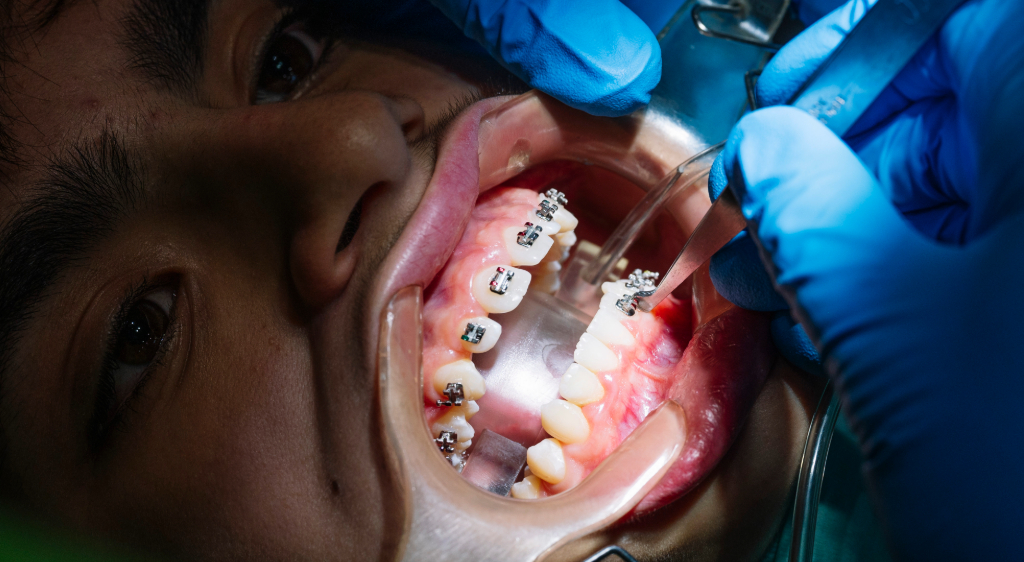Having braces is a commitment to achieving a beautiful, aligned smile, but it also creates its own set of unique challenges when it comes to oral hygiene.
One of the most persistent issues braces wearers face is tartar buildup.
The brackets, wires, and bands create countless tiny spaces where food particles and plaque can hide, eventually hardening into stubborn tartar deposits that are difficult to remove.
Maintaining clean teeth while wearing braces isn’t just about aesthetics; it’s crucial for your long-term oral health.
Without proper care, tartar buildup can lead to gum inflammation, decay around brackets, and even permanent staining when your braces are finally removed. Instead of enjoying your newly straightened smile, you might be dealing with unexpected dental problems.
In this comprehensive guide, we’ll explore effective strategies specifically designed for braces wearers to combat tartar buildup. You’ll learn about specialized tools, proper cleaning techniques, and products that can make a significant difference in your oral health journey with braces.
By implementing these approaches, you can ensure that when those braces come off, your smile is not only perfectly aligned but also healthy and bright.
Understanding Tartar & Braces
Tartar, also known as dental calculus, begins as plaque, a sticky, colorless film of bacteria that constantly forms on your teeth.
When plaque isn’t removed through regular brushing and flossing, it hardens into tartar within 24-72 hours. Unlike plaque, tartar cannot be removed by brushing alone and creates a rough surface that attracts even more plaque.
The Unique Challenges of Braces
For brace wearers, this natural process becomes considerably more challenging. The brackets, wires, and bands of your orthodontic appliance create numerous small spaces that are difficult to clean properly.
These areas become perfect hiding spots for food particles and bacteria, accelerating plaque formation and, consequently, tartar buildup.
Tartar typically accumulates in predictable locations when you have braces:
- Around the base of the brackets where they attach to your teeth
- Under archwires where your toothbrush can’t easily reach
- Near the gumline, particularly behind the lower front teeth
- Around molar bands or other orthodontic attachments
Identifying Tartar
You can identify tartar by looking for yellowish or brownish deposits that won’t brush away. Unlike food particles or temporary staining, tartar feels hard and rough when you touch it with your tongue. In more severe cases, you might notice gum inflammation, tenderness, or even bleeding when brushing.
All signs that tartar has begun to affect your gum health.
Understanding this process is the first step toward preventing tartar buildup with braces.
By recognizing how and where tartar forms, you can target your cleaning efforts more effectively and maintain better oral health throughout your orthodontic treatment.
Essential Tools for Tartar Control
Effectively managing tartar with braces requires specialized tools.
Standard toothbrushes and basic flossing aren’t enough to clean around orthodontic hardware.
Specialized Toothbrushes for Braces
Orthodontic toothbrushes feature V-shaped bristle patterns designed to clean both above and below brackets and wires, reaching areas standard brushes miss.
Powerful Toothpaste Solutions
TartarEnd® toothpaste is specifically formulated to dissolve tartar and plaque both above and below the gumline, which is crucial for braces wearers. It works to stop bleeding gums and can help reduce gum pocket depths, common concerns with orthodontic appliances.
Optimal Brushing Technology
Pairing TartarEnd® with a high tip-speed sonic toothbrush like the Philips Sonicare Series 4100 creates a powerful combination. The 31,000 vibrations per minute drive active ingredients around brackets and below the gumline, dissolving tartar in areas manual brushing might miss.
Water Flossers
Water flossers use pressurized water to clean between teeth and around brackets, flushing out food particles and bacteria that traditional flossing might miss. Many orthodontists now recommend these as essential for braces wearers.
Interdental Brushes & Proxy Brushes
These small, cone-shaped brushes navigate tight spaces between wires and teeth, removing plaque before it hardens into tartar.
Orthodontic Floss Threaders
Floss threaders help guide floss between teeth and underwires, making thorough cleaning possible in hard-to-reach areas.
Antimicrobial Mouth Rinses
Quality antimicrobial mouth rinses reduce bacteria in your mouth, complementing your mechanical cleaning methods. Look for alcohol-free formulations that won’t irritate sensitive gums.
Using these specialized tools consistently will help prevent tartar buildup throughout your orthodontic treatment.
Daily Cleaning Routine
Maintaining clean teeth with braces requires a consistent, thorough cleaning routine. Here’s a step-by-step approach to keep tartar at bay.
Morning & Evening Routine
Step 1: Rinse First
Begin by rinsing with water to loosen food particles and debris around your braces.
Step 2: Brush Methodically
- Apply TartarEnd® toothpaste to your orthodontic toothbrush
- Brush at a 45-degree angle to the gum line
- Clean above each bracket, then below each bracket
- Brush the chewing surfaces and inside surfaces of teeth
- Don’t rush—spend at least 2 minutes total
Step 3: Floss Thoroughly
- Use a floss threader to guide floss underwires
- Curve the floss around each tooth in a C-shape
- Gently move the floss up and down against the side of each tooth
- Pay special attention to the areas near the gum line
Step 4: Finish with Interdental Cleaning
- Use interdental brushes or proxy brushes to clean around brackets and under wires
- Focus on areas where your regular toothbrush can’t reach
- Gently insert the brush between the brackets and wires
Step 5: Optional Rinse Finish with an antimicrobial mouth rinse to help reduce bacteria.
Post-Meal Quick Clean
After eating, follow these quick steps:
- Rinse thoroughly with water
- Use a proxy brush to remove visible food particles
- If possible, brush with TartarEnd® toothpaste
- If brushing isn’t possible, rinse with water or mouthwash
Consistency is key.
Following this routine both morning and night, with quick cleanings after meals, will significantly reduce tartar buildup while wearing braces.
Professional Tartar Removal
Even with excellent home care, professional cleanings remain essential while wearing braces. Here’s what you need to know about professional tartar management.
Scheduling Regular Cleanings
Most orthodontists recommend more frequent professional cleanings while wearing braces, typically every 3-4 months rather than the standard 6-month interval. These more frequent visits allow dental professionals to remove tartar buildup before it causes problems.
What To Expect During a Cleaning
Professional cleanings with braces differ slightly from standard cleanings:
- The hygienist will use specialized tools to clean around brackets and wires
- They may remove some elastic bands or wires if necessary (which your orthodontist will replace)
- The cleaning may take longer than usual due to the additional care required
- You might experience slightly more sensitivity during and after the cleaning
Orthodontist Visits vs General Cleanings
Regular orthodontist appointments focus on adjusting your braces and monitoring your teeth alignment. While they’ll check for obvious issues, these visits don’t replace professional cleanings with your dentist or dental hygienist. Maintain both types of appointments for optimal oral health.
Questions To Ask Your Dental Professional
During your cleaning appointments, consider asking:
- Which areas show the most tartar buildup?
- Are there specific techniques you should adjust in your home care routine?
- Is there evidence of enamel demineralization around your brackets?
- Would additional products or tools benefit your specific situation?
Professional cleanings complement your home care routine, removing tartar that has formed despite your best efforts and providing guidance to improve your cleaning techniques.
Dietary Considerations
What you eat significantly impacts tartar formation, especially with braces. Making smart dietary choices helps reduce tartar buildup while protecting your orthodontic hardware.
Foods That Promote Tartar Formation
Avoid or limit these tartar-encouraging foods:
- Sugary foods and beverages (candy, soda, sports drinks)
- Starchy snacks (chips, crackers, white bread)
- Acidic foods and drinks (citrus fruits, tomato-based sauces)
- Sticky foods that cling to braces (caramel, gummy candies)
- Hard foods that can damage braces and leave particles trapped
Braces-Friendly Foods That Help Reduce Tartar
Incorporate these tartar-fighting options:
- Crunchy fruits and vegetables (cut into small pieces)
- Calcium-rich foods (yoghurt, cheese, milk)
- High-fiber foods that stimulate saliva production
- Foods rich in vitamin C to support gum health
- Sugar-free options whenever possible
Hydration & Oral Health
Water is your ally against tartar:
- Drink water throughout the day to rinse away food particles
- Choose water instead of sugary or acidic beverages
- Rinse with water after meals when brushing isn’t possible
- Consider fluoridated water for additional protection against decay
Supplements That Support Dental Health
Some supplements may support oral health during orthodontic treatment:
- Calcium and vitamin D for tooth strength
- Vitamin C for gum health
- Coenzyme Q10 for gum tissue support
- Probiotics to help maintain a healthy oral bacterial balance
Making thoughtful dietary choices complements your cleaning routine and helps minimize tartar formation while wearing braces.
Troubleshooting Common Issues
Even with diligent care, braces wearers may encounter challenges with tartar buildup. Here’s how to address common problems.
Persistent Tartar Spots
If you notice stubborn tartar despite regular cleaning:
- Focus extra attention on these areas while brushing
- Increase the frequency of interdental cleaning in problem areas
- Try using TartarEnd® toothpaste more frequently on these spots
- Consider whether your brushing technique needs adjustment
- Consult your dental professional if spots persist
Managing Gum Sensitivity & Inflammation
- Brush gently but thoroughly along the gum line
- Use a soft-bristled brush if sensitivity increases
- Apply TartarEnd® carefully around inflamed areas
- Rinse with warm salt water to soothe irritation
- Schedule a dental check-up if inflammation persists for more than a few days
Addressing Discoloration
White spots or discoloration around brackets can indicate early decay:
- Improve cleaning techniques in affected areas
- Ensure you’re using products that contain appropriate minerals
- Discuss fluoride treatments with your dentist
- Document these areas with photos to monitor changes
- Don’t wait until your braces come off to address these issues
When To Seek Immediate Attention
Contact your dental professional immediately if you experience:
- Persistent bleeding when brushing
- Significant gum recession
- Severe pain around specific teeth
- Loose brackets or bands
- Signs of infection like swelling or unusual discharge
Addressing these issues promptly prevents minor problems from becoming major complications.
Your Brightest Smile Awaits!
Successfully managing tartar while wearing braces requires consistent effort, but the results are worth it.
By understanding how tartar forms, using specialized tools like TartarEnd® toothpaste, following a thorough cleaning routine, making smart dietary choices, and addressing problems quickly, you’ll maintain healthy teeth and gums throughout your orthodontic treatment.
Ready to tackle tartar and protect your investment in a beautiful smile?
Try TartarEnd® toothpaste as part of your comprehensive approach to braces care.






